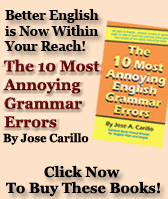- HOME
- ENGLISH FORUM
- BADLY WRITTEN, BADLY SPOKEN
- GETTING
TO KNOW ENGLISH - PREPARING FOR ENGLISH PROFICIENCY TESTS
- POUR OUT YOUR MIND IN ENGLISH
- GOING DEEPER INTO ENGLISH
- YOU ASKED ME THIS QUESTION
- EDUCATION AND TEACHING FORUM
- ADVICE AND DISSENT
- MY MEDIA ENGLISH WATCH
- NOTABLE WORKS BY OUR VERY OWN
- ESSAYS BY JOSE CARILLO
- ABOUT JOSE CARILLO
- READINGS ABOUT LANGUAGE
- TIME OUT FROM ENGLISH GRAMMAR
- NEWS AND COMMENTARY
- BOOKSHOP
- ARCHIVES
TIME OUT FROM ENGLISH GRAMMAR
This section features wide-ranging, thought-provoking articles in English on any subject under the sun. Its objective is to present new, mind-changing ideas as well as to show to serious students of English how the various tools of the language can be felicitously harnessed to report a momentous or life-changing finding or event, to espouse or oppose an idea, or to express a deeply felt view about the world around us.
The outstanding English-language expositions to be featured here will mostly be presented through links to the websites that carry them. To put a particular work in better context, links to critiques, biographical sketches, and various other material about the author and his or her works will usually be also provided.
I hope you’ll enjoy the new selections that will be presented here each week.Joe Carillo
Physicist wows, then humiliates scientists with fool’s gold
Historians over the centuries have recognized the value of forgeries and fakes in giving invaluable clues about the wider culture in which they were made. One of them, the Princeton University historian Anthony Grafton, even argued in a 1990 book that much of the scholarship in the humanities today matured because of the constant back-and-forth engagement with frauds and forgeries. But one audacious set of forgeries that wowed but soon terribly scandalized the science community was the one foisted by Jan Hendrik Schön, a Bell Laboratories physicist and researcher who, between 2001 and 2002, claimed that he had created organic plastics that became superconductors or lasers, making it possible to make computer chips that one could stick on a dress or eyewear and to make electronic screens as thin and easy-to-fold as sheets of paper. Editors of respected science publications even hailed one of Schön’s supposed inventions as “breakthrough of the year” for 2001.

But as former New Scientist editor Eugenie Samuel Reich recounts in her book PLASTIC FANTASTIC: How the Biggest Fraud in Physics Shook the Scientific World, Schön’s purported inventions were nothing but fool’s gold. After a formal investigation, Schön was dismissed by Bell Laboratories for scientific misconduct that fell into three basic categories: “substitution of data,” “unrealistic precision of data” and “results that contradict known physics.” The investigating committee concluded that at least 16 of his scientific papers showed clear evidence of manipulation and fraud.
In telling the story of the rise and fall of Schön, David Kaiser says in his review of the book for The American Scientist, Reich has come up not only with a compelling whodunit but also with a fascinating cautionary tale about the ways of modern science. “Most interesting is that Schön’s frauds actually benefited from rigorous peer review at elite journals, much as earlier forgers benefited from the advanced techniques of text-obsessed humanists,” Kaiser says. In another review for Scienceblogs.com, Janet Stemwedel says that “Perhaps Schön’s submissions were instructive in demonstrating what can happen when your main screening criterion is driven by what seems exciting or important, rather than by what has lined up enough robust evidence and fit with our theoretical understanding that it is likely to be true.”
Read David Kaiser’s “Physics and Pixie Dust” in The American Scientist now!
Read Janet Stemwedel’s review of Plastic Fantastic in Scienceblogs.com now!







